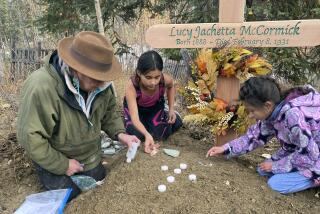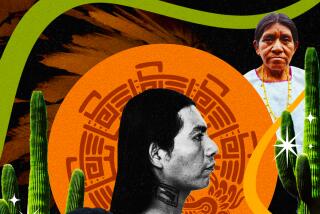Last Eyak worked to preserve native language
Marie Smith Jones, the last full-blooded Eyak and fluent speaker of her native Alaskan language, died in her sleep Monday at her home in Anchorage, her family said. She was 89.
Michael Krauss, a linguist and professor emeritus at the University of Alaska at Fairbanks, collaborated with Jones for years in an effort to preserve the Eyak language, a branch of the Athabaskan family of languages.
âWith her death, the Eyak language becomes extinct,â Krauss said.
Jones was honorary chief of the Eyak Nation of south-central Alaska. The Eyak ancestral homeland runs along 300 miles of the Gulf of Alaska from Prince William Sound, near the fishing village of Cordova, east across the Copper River Delta to the town of Yakutat. By the 21st century, only about 50 Eyaks remained, according to the Alaska Native Language Center, which is headed by Krauss.
Jones spoke twice at the United Nations on peace and the importance of indigenous languages, said her daughter, Bernice Galloway. She also became active in environmental issues.
Krauss described Jones as a âwonderfully ordinary Eyak lady who lived to a ripe old age not because of an easy life but because of a rather hard life, coming up and surviving as an Eyak in the 20th century.â
For the last 15 years, Krauss said, Jones was the last of her kind.
âThat was a tragic mantle that she bore with great dignity, grace and spirit,â he said.
With Jonesâ help, Krauss compiled an Eyak dictionary and grammar guide. Jones, her sister and a cousin told him Eyak tales that were made into a book. She wanted a written record of the language so future generations would have the chance to resurrect it, Krauss said.
After the death of her sister in 1992, the New Yorker wrote about Jones and her disappearing language.
âHow would you feel if your baby died?â Jones told the reporter. âIf someone asked you, âWhat was it like to see it lying in the cradle?â â
Jones was born in Cordova on May 14, 1918, and grew up on Eyak Lake, where her family had a homestead. Many of her siblings died young when smallpox and influenza tore through the Eyak Nation.
She married William F. Smith, a fisherman from Oregon, on May 5, 1948. The couple had nine children, seven of whom survive her. None of them learned Eyak because they grew up at a time when it was considered wrong to speak anything but English, Galloway said.
Jones moved to Anchorage in the early 1970s to be closer to her children. She struggled with alcoholism until she was in her early 50s, and quit drinking, Galloway said.
More to Read
Sign up for Essential California
The most important California stories and recommendations in your inbox every morning.
You may occasionally receive promotional content from the Los Angeles Times.










